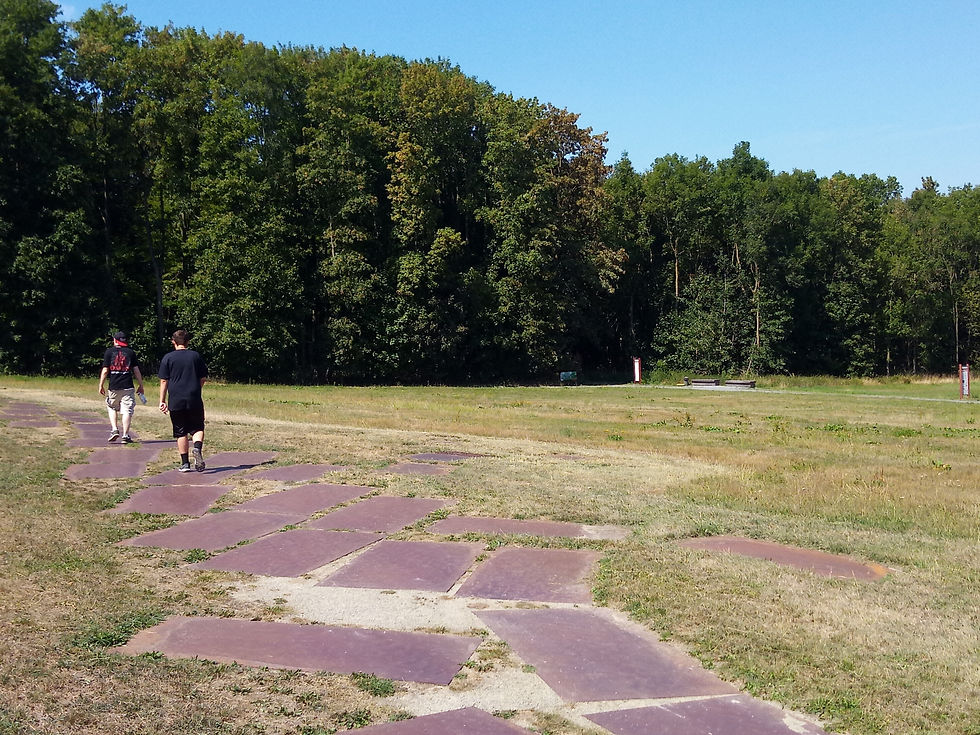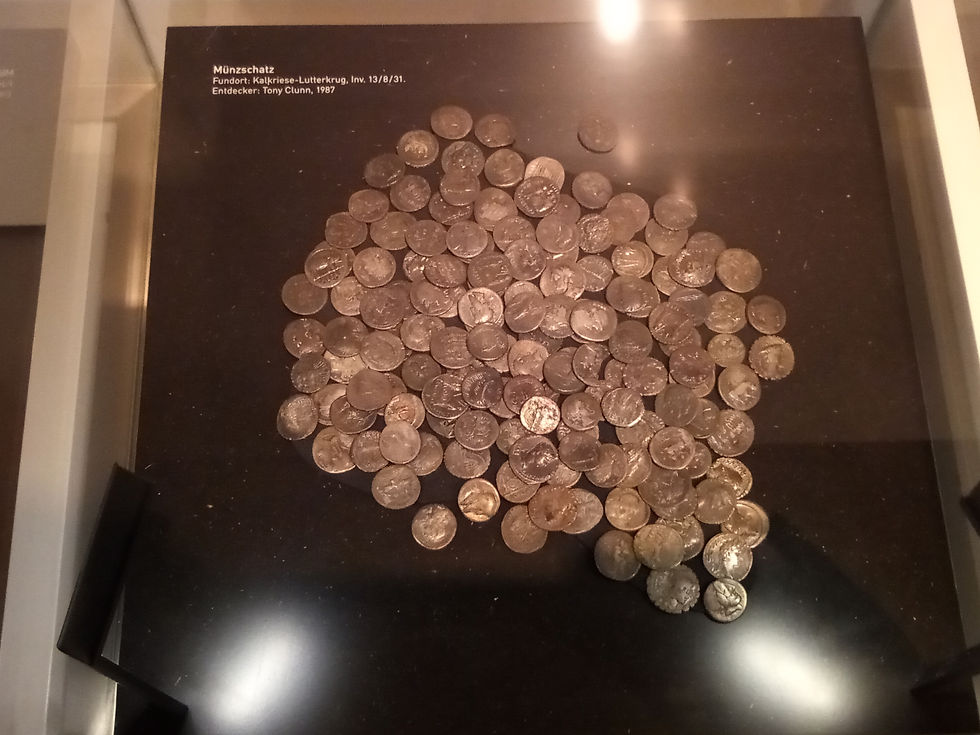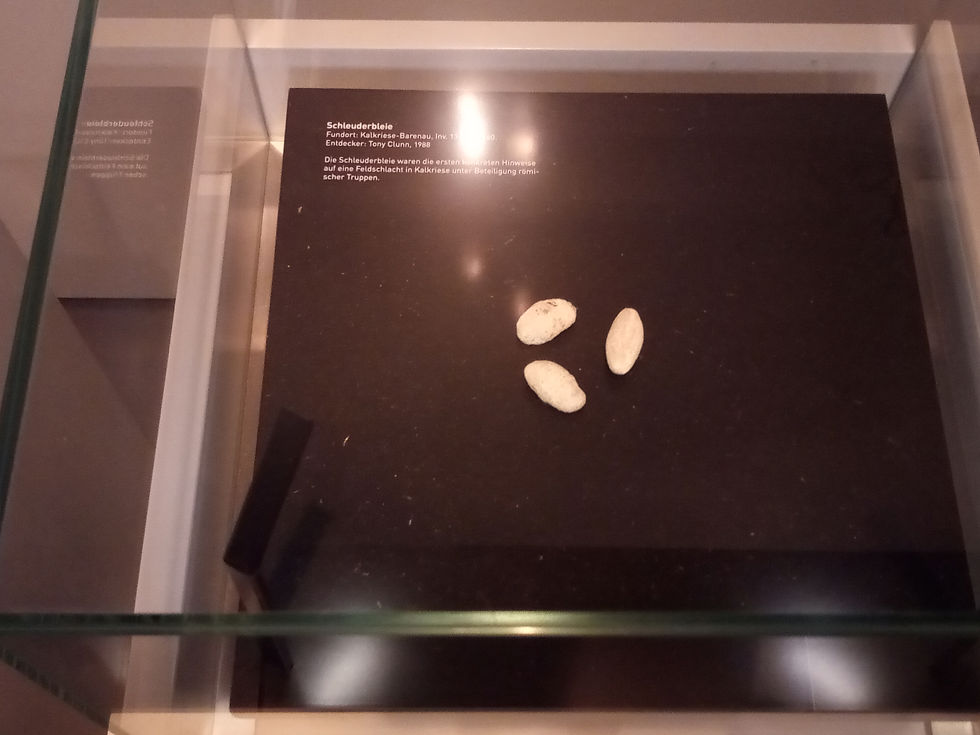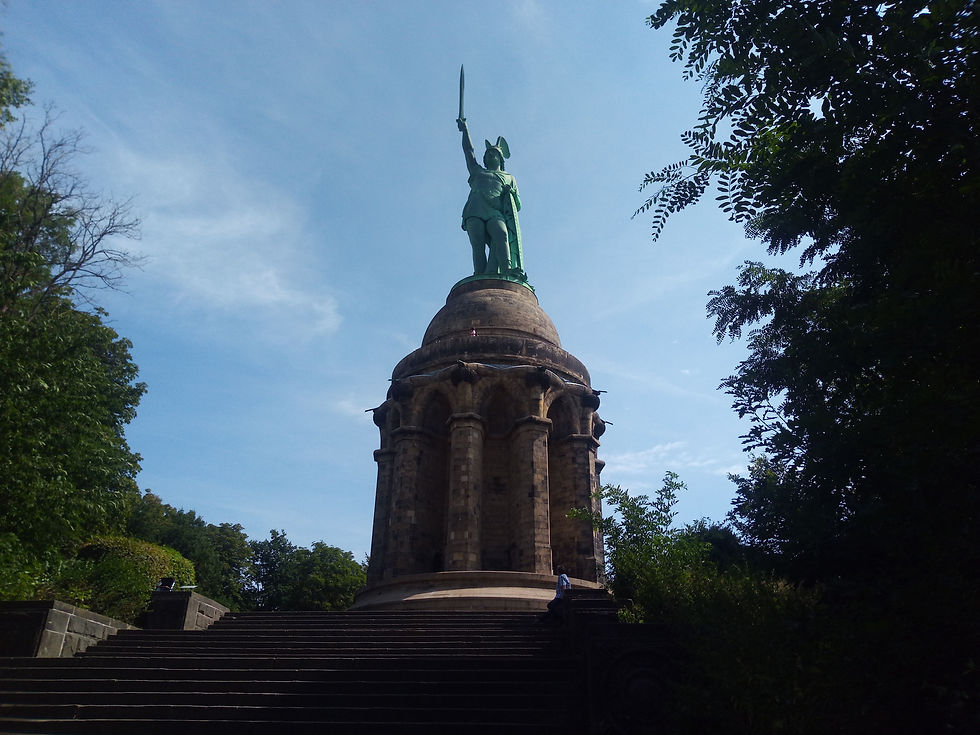Arminius, the Germanic Heathen who handed Rome her Greatest Defeat
- Robert Sass
- Nov 11, 2019
- 12 min read
Updated: Oct 24, 2020
Arminius (Latin) or Hermann (German) was born in the year 18/17 BC and was killed in 21 AD. Arminius was the son of the Cheruscan chief Segimerus (German: Segimer). Taken as a hostage in his youth, he lived in Rome, where he learned to speak Latin and trained as a Roman military commander alongside his younger brother Flavus. He served in the Roman army between AD 1 and 6 and received a military education as well as Roman citizenship and the status of equite before returning to Germania. These experiences gave him knowledge of Roman politics and military tactics, which allowed him to successfully anticipate enemy battle maneuvers during his later campaigns against the Roman army. Arminius lead the North Germanic Heathen tribes in the battle to keep their freedom from the Roman Empire. He led the Germanic tribes of northern Germany who annihilated 22,000 Roman soldiers, three entire legions, and sent the Roman Commander Varus’s head back to Rome. Historians almost universally agree that Arminius gave Rome her greatest defeat in one of the most lopsided battles in history. Arminius’ victory lead to Rome’s permanent withdrawal from “Germania,” leaving Europe divided in two for eight hundred years until Charlemagne conquered Northern Germany and the Saxons in 804 AD, uniting Europe. Due to Arminius’ victory, Germanic Heathenry thrived among the Germanic tribes until Charlemagne’s time almost 800 years later, as forced Christianization was the policy of Europe’s Christian conqueror. Without Arminius, we may not know Old Saxon Heathenry, or Aldsidu today.
Arminius' name was not 'Hermann' despite what the German school-system has taught for two centuries. In the early 18th Century German historians Germanized the name Arminius as Hermann. Hermann was not a name that was used in the first century, and linguistically it must be rejected. There are only two possibilities for the name Arminius: 1. Arminius could be his Latin name given to him by the Romans that he used in his time in Rome, just as Arminius’ brother called himself “Flavus,” an extremely Roman and non-Germanic name. Due to Roman naming conventions of the time, it is likely Arminius is an adopted name granted to him upon citizenship, not his Cheruscan birth name. 2. Arminius could be a Latinized version of his proto-Old Saxon (or early Germanic) name. If so, his name would have been something like *'Irminas' meaning “strong.” The meaning of “Cherusker” is debated. Some believe it comes from “herut” meaning “deer.” Jacob Grimm, and others, have argued that the name derives from heru, meaning "army." The Cherusker, Fosi, Suebi, Angrivarri, Chauci, and other tribes did merge into the Saxon tribal confederation, i.e. “single edged sword people.”
The first historical mention of the Cherusci occurs in Book 6.10 of Julius Caesar's De Bello Gallico, describing the events of 53 BC. Caesar states he crossed the Rhine to punish the Suebi for reinforcing the Treveri. He mentions that the Bacenis forest (the Harz forest) divided the land of the Cherusci from the Suebi. These tribes are described as living in the same homeland when Tacitus wrote his Germania, 150 years later. Tacitus writes of the Cherusci of his time (about 100 AD): “Dwelling on one side of the Chauci and Chatti, the Cherusci long cherished, unassailed, an excessive and enervating love of peace. This was more pleasant than safe, for to be peaceful is self-deception among lawless and powerful neighbors. Where the strong hand decides, moderation and justice are terms applied only to the more powerful; and so, the Cherusci, ever reputed as good and just, are now called cowards and fools, while in the case of the victorious Chatti success has been identified with prudence. The downfall of the Cherusci brought with it also that of the Fosi, a neighboring tribe, which shared equally in their disasters, though they had been inferior to them in prosperous days.” [Crossland, David (August 28, 2009). "Battle of the Teutoburg Forest: Germany Recalls Myth That Created the Nation". Spiegel Online International. Der Spiegel. Retrieved January 16, 2015.] Claudius Ptolemy, in his Geography, describes the Χαιρουσκοὶ and Καμαυοὶ (Cherusci and Chamavi) as living near each other and the Harz Mountains. The Cherusker became a Roman vassal tribe in 12 BC, and by Roman policy, children of nobles were taken as hostages to be raised in Rome. One of these hostages was the young Arminius and his brother Flavus, taken from their Cherusci family to be raised in Rome as a vassal tribe's Roman obligation.
Writing in the second century CE, Roman historian Cassius Dio describes in chapter 50 of his Roman History an encounter between Nero Claudius Drusus and a woman with supernatural abilities among Cherusci. According to Diorites Cassius, the woman foresees Drusus's death, and he dies soon thereafter: Herbert Baldwin Foster and Earnest Cary translation (1917): "The events related happened in the consulship of Iullus Antonius and Fabius Maximus. In the following year Drusus became consul with Titus Crispinus, and omens occurred that were anything but favorable to him. Many buildings were destroyed by storm and by thunderbolts, among them any temples; even that of Jupiter Capitolinus and the gods worshipped with him was injured. Drusus, however, paid no heed to any of these things, but invade the country of the Chatti and advanced as far as that of the Suebi, conquering with difficulty the territory transversed and defeating the forces that attacked him only after considerable bloodshed. From there he proceeded to the country of the Cherusci, and crossing the Visurgis, advanced as far as the Albis, pillaging everything on his way. The Albis rises in the Vandalic Mountains, and empties, a mighty river, into the northern ocean. Drusus undertook to cross this river, but failing in the attempt, set up trophies and withdrew. For a woman of superhuman size met him and said: "Whither, pray, art thou hastening, insatiable Drusus? It is not fated that thou shall not look upon all these lands. But depart; for the end alike of thy labours and of thy life is already at hand". It is indeed marvellous that such a voice should come to any man from the Deity, yet I cannot discredit the tale; for Drusus immediately departed, and as he was returning in haste, died on the way of some disease before reaching the Rhine. And I find confirmation in these incidents: wolves were prowling about and howling just before his death; two youths were seen riding through the midst of the camp; a sound as of a woman lamenting was heard; and there were shooting stars in the sky. So much for these events."
Arminius’ (Irminas’) Life
Born of a noble family in the Cherusci tribe, Arminius was made a hostage of the Roman Empire as a child. Raised in Rome, he was drafted into the Roman military at an early age, during which he was granted Roman citizenship. After serving with distinction in the Great Illyrian Revolt, he was granted the rank of “Roman Knight” and was put in charge of auxiliary troops, soldiers. Arminius was sent to Germania in 7AD to aid the local governor Publius Quinctilius Varus in completing the Roman conquest of the Germanic tribes. Normally, hostages who were more than a decade removed from their birth families, did not revert back to their tribe's culture. Most loved Roman culture, and remained proud Romans, usually looking at their country of birth as an inferior barbarian one. Hence, in the Roman mind, countrary to our modern minds, Arminius changing sides was not a normal concern. Hindsight is 20/20. Considering Arminius' brother Flavus fought against his brother and against the Germanic tribes as a Roman soldier, he is the more common example. The common Roman example of barbarians can become civilized.
When Arminius arrived back in his Ancestral Homeland as a Roman citizen and knight of the Auxilary division, he reunited with his family and clan. Segestes, a Cherusci chieftain, had been Rome’s vassal of the Cherusci. Arminius and Segestes, each had different views and a split began to form in the Cherusci tribe. Arminius stirred hearts for a rebellion, while Segestes advocated for remaining allied with Rome, a military force he felt the Germanic Tribes could not defeat. By about 8 AD, Arminius had gained the upper hand in the Chersuci tribe and began planning rebellion. Segestes repeatedly warned Publius Quinctilius Varus, the governor of Gaul and leader of Roman troops in Germania, that rebellion was being planned, but Varus declined to act believing that Arminius was not colluding with his own tribesmen as a Roman knight, behind Varus' back. Varus simply would not believe that Arminius, once a child taken as a hostage from his homeland, would re-unite with that homeland, having fought with such distinction. For a great and free YouTube documentary on Arminius, please check out this video. It can be bought in HD on Amazon. https://www.youtube.com/watch?v=RbZVrWUlJ0A&t=355s
Battle of the Teutoburg Forest & Its Aftermath In the autumn of AD 9, the 25-year-old Arminius was well prepared, and set his plan in motion. When the Roman troops broke from their summer camp in Germania and began marching back to Roman Gaul for the winter (on foot), the entire three legions and the accompanying women and children were left in the open. Rome's armies were invincible over many other nations and the Germanic tribes. Rome's army was the world's best on open ground. Arminius knew this. But Arminius knew if he could persuade Varus to lead his troops into the forest, all the advantages of the Roman army would be neutralized. Hence, before the Roman army began its march, Arminius told Varus that Segestes was right, that there was a surprise attack brewing, and that the auxilarary troops, lead by Arminius, should go ahead and search out this rebellion. Arminius was placed in charge of Roman Auxilary troops, which was basically scout cavalry. When Arminius went ahead to prove the route safe, he was simply executing the first part of his plan. Arminius and his scouts, all Germanic tribesmen raised in Rome as hostages, turned on Rome. They attacked a Roman outpost stationed in a forest clearing. The Roman soldiers there had no chance, as men that they knew as Romans and dressed as Romans approached them, and annihilated them in a surprise attack. Arminius then set this outpost on fire. He persuaded Varus to divert the three legions under his command (composed of the 17th, 18th, and 19th legions, plus three cavalry detachments and six cohorts of auxiliaries), which were at the time marching to winter quarters, to suppress the rebellion by going into the Germanic forest. Varus and his legions marched right into the trap that Arminius had set for them near Kalkriese. Arminius had tribesmen, well versed in archery and as spearmen hidden in the forest. He also had the area near Kalkriese, where there was an openning of the forest, prepared. There Arminius built a woden rampart wall with archers, spearmen, and javelin throwers. He knew the legions would be forced to walk between this wall and a muddy marsh, where Roman horses and wagons would get bogged down. Arminius' tribe, the Cherusci, and their allies the Marsi, Chatti, Bructeri, Chauci, and other tribes, ambushed and annihilated Varus' entire army, totaling over 22,000 men, as it marched along a narrow road through a dense forest. Recent archaeological finds show the long-debated location of the three-day battle was almost certainly near Kalkriese Hill, about 20 km north of present-day Osnabrück. I will post pictures of the site below, as well as pictures from the museum. When defeat was certain, Varus committed suicide by falling on his sword (if we are to believe Roman sources.) The battle was one of the most devastating defeats Rome suffered in its history. Arminius' success in destroying three entire legions and driving the Romans out of Germany marked a high point of Germanic power for centuries. Roman attempts to reconquer Germania failed, and Tiberius ordered a withdrawal of Roman troops from Germania. This divided Europe in two, the Germanic Heathens in the North, and the rest of Europe (in fact, most of Europe), doomed to go down the path of not only the Roman Empire, but eventually Rome’s (soon to be) new religion, Christianity, which Rome later adopted wholesale. Arminius’ victory allowed Germanic Heathenry to flourish outside the Roman Empire, and outside of Christianity.
After the battle, the Germans quickly annihilated every trace of Roman presence east of the Rhine. Roman settlements such as the Waldgirmes Forum were wiped out. The vastly outnumbered Roman garrison of Haltern am See, under the command of the prefect Lucius Cedicius, inflicted heavy losses on the Germans before retreating into Gaul, resisting long enough for Lucius Nonius Asprenas to organize the Roman defense on the Rhine and the Roman Emperor Tiberius to arrive with a new army. This prevented Arminius from crossing the Rhine and invading Gaul. Please note, Gaul, or Modern France, was Celtic, not Germanic. These peoples had been Roman for some time, and the Romans regarded the "Keltoi" as more advanced than the "Germani." The Celts had in the Roman mind, a more civilized society, and roads. The Germanic tribes in battle here, who would become the Saxons, did not believe in Kings. They lived not as united tribes, each group independent, often fighting amongst each other. And more importantly, the Germani lived in forests, and were avid hunters, fishermen, and farmed small areas of land. The Romans hated the forests, most of which were chopped down in Italy due to its civilization. Roman soldiers were terrified in the forests, and realized clearly they did not belong. Many felt Rome should not worry about Germania, as it had in their eyes, little resources to offer the Roman Empire.
Between AD 14 and 16, Germanicus led punitive operations into Germania, trying to restore some Roman honor, fighting Arminius to a draw in the Battle at Pontes Longi and twice defeating him (per Tacitus): first in the Battle of Idistaviso and later at the Battle of the Angrivarian Wall. Emperor Tiberius denied the request of Germanicus to launch an additional campaign for AD 17, having decided the frontier with Germania would be at the Rhine river. The area of modern Germany was in a sense divided in two. Northern Germany, or Saxony, would remain outside of the Roman Empire. Southern Germany, south of the Danube, and Gaul west of the Rhine, would remain Roman. This is one reason why North and South Germany have different cultures today. Rome simply gave up on Northern Germany, and Scandinavian lands to the North. This kept Germanic Heathenry alive in these countries for centuries.
Arminius had opposition from his father-in-law Segestes and other pro-Roman Germanic leaders. Arminius also faced opposition from the North Germanic tribes that he led. These tribes, who became the Saxons later, did not believe in kings/Kaisers/dictators, as the Saxons later did not. Arminius’ brother Flavus, who had been raised alongside him in Rome, remained loyal to the Roman Empire and fought under Germanicus against Arminius at the Battle of Idistaviso. (Tacitus, The Annals 2.88) Arminius was murdered by nobles of the Germanic tribes (who became the Saxons) that he was able to unify against Rome. While they felt Arminius rejected Rome’s culture and drive for foreign domination, they did not feel that he rejected Rome’s ideal of a Dictator or Emperor (Kaiser). Per Tacitus, Arminius was killed for precisely this reason, that the Germanic tribes wished to remain independent, and not united. Tacitus, Annals 2.22 ff.; Suetonius, Caligula 1.4; Dio 57.18.1; on Arminius' assassination, Tac. Ann. 2.88. Tacitus also records that Emperor Tiberius allegedly had refused an earlier offer from a Chatti nobleman to poison Arminius: "It was not by secret treachery but openly and by arms that the people of Rome avenged themselves on their enemies." Tac. Ann. 2.87–88.
In the accounts of his Roman enemies, Arminius is highly regarded for his military leadership and as a defender of the liberty of his people. Based on these records, the story of Arminius was revived in the 16th century with the recovery of the histories of Tacitus, who wrote in his Annales II, 88: “Arminius, without doubt Germania's liberator, who challenged the Roman people not in its beginnings like other kings and leaders, but in the peak of its empire; in battles with changing success, undefeated in the war.”
During the unification of Germany in the 19th century, Arminius was hailed by German nationalists as a symbol of German unity and freedom. Following World War II, Arminius was omitted from German textbooks due to his association with militaristic nationalism, and many modern Germans are unaware of his story. In 2009, the 2000th anniversary of his victory at the Teutoburg Forest was only lightly commemorated in Germany. This is despite the fact that Arminius was nothing like Hitler. Arminius defended his homeland from foreign aggression, and was not an agitator. Arminius fought for the freedom of his people, and Hitler fought to expand Germany's Reich (Empire.)
The German translation of the name Arminius as Hermann dates from the 16th century, possibly first by Martin Luther. In German, Arminius is traditionally known as Hermann der Cherusker ("Hermann the Cheruscan") or Hermann der Cheruskerfürst ("Hermann the Cheruscan Prince"). Hermann etymologically means "Man of War", coming from the Old High German heri "war" and man "man".
Other Facts
Arminius married a noble woman named Thusnelda, whose name is preserved only by Strabo. She was Segestes daughter, the Segestes who at first wished to remain loyal to Rome, but changed sides during the battle, when Arminius' victory was inevitable. Thusnelda was captured by the Romans while pregnant, so her son Thumelicus grew up in Roman captivity. Tacitus describes him as having an unusual story, which the historian promises to tell, but this part of Tacitus' writings has since been lost.
Please join us on the Facebook Group: Saxon Heathenry. Please visit us at www.aldsidu.com
Pictures from my study trip to Kalkriese, the battle site where Arminius had the final assault on the three legions of Varus. Please note, a silver cavalry mask was uncovered by archaeologists, as well as Roman coins, Roman weapons, Roman sling shots. The Museum at Kalkriese is called "Varusschlacht" meaning "the Battle of Varus." Interesting it is not named after Arminius. Below those pictures, are pictures of the Herman Denkmal near Detmold Germany.



















Comments